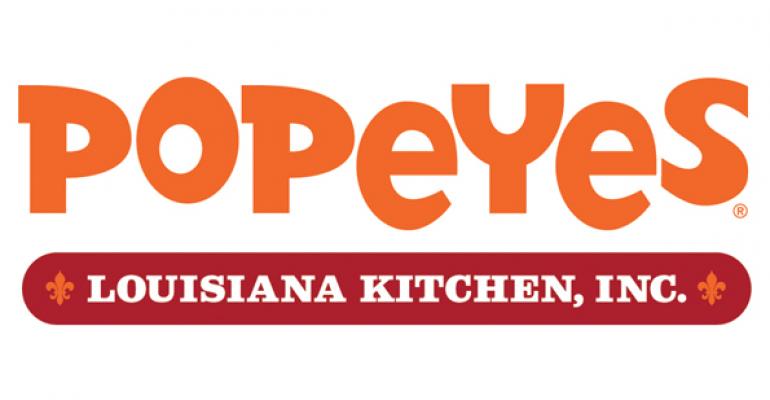
Popeyes Louisiana Kitchen Inc. launched its first mobile app last week at the South by Southwest conference, in conjunction with a preview of its spicy new Red Stick Chicken limited-time offer, which will debut Monday.
The new app — Popeyes’ first app launch of any kind — highlights a shift toward digital in the Atlanta-based operator’s marketing strategy, which has long focused primarily on television advertising. Even the brand’s presence at the youth-oriented music, film and technology conference indicated a new focus on next-generation consumers.
The app is the first example of what Hector Munoz, Popeyes vice president and chief marketing officer-U.S., described as an increasing emphasis on more comprehensive promotions that will use multiple mediums to get the brand’s message across.
“Our content strategy is to be on any screen, any time, anywhere, and that means traditional TV, online or mobile devices,” Munoz said. “We know more and more people are using multiple screens to gather their content.”
The app, which uses a unique face-recognition technology, lets users play a game of chicken with a virtual chicken. The test is to see who will blink, turn away or scratch their face first.
As competitors like Chick-fil-A expand digital features like mobile ordering and payment, Popeyes has some catching up to do. But Munoz said the company is on it.
As the number of restaurants within the nearly fully franchised chain climbs, so does its marketing budget, Munoz said. The marketing push comes at a time when the quick-service chain is reporting strong performance.
Popeyes has reported six consecutive years of same-store sales growth, including a 6.2-percent increase in fiscal 2014. Average unit volume has grown more than 25 percent during that time, to $1.6 million in 2013 for new domestic freestanding units. The 2,379-unit chain has set a goal of doubling its 1,870-unit domestic footprint within the next few years.

“We’re becoming a big brand. When you become a big brand, you do big things,” Munoz said.
Popeyes’ success is largely due to a brand transformation that began about seven years ago, said Munoz, who became CMO in September 2014, after serving as Popeyes’ vice president of marketing.
One component was changing its name in 2008 from Popeyes Chicken and Biscuits to Popeyes Louisiana Kitchen, a transition that allowed the chain to broaden its menu beyond the traditional bone-in chicken, and add boneless options along with seafood.
“It gave us the ability to tap into the richness of what is Louisiana culinary, which is our heritage,” Munoz said.
With that effort came the TV spokeswoman Annie, a character featured in television ads over the past five years who has become somewhat of an icon, Munoz said.
“Annie gets better with every single execution, to the point where now she’s a trusted confidant for our consumers,” he said.
But now that Popeyes is on national television for about 12 months out of the year, Munoz said the company is looking to expand marketing efforts into more digital and social media channels.
At South by Southwest, the app was showcased as Popeyes gave out some 3,500 samples of its Red Stick Chicken, which is made with Tabasco sauce.
“We debuted it at South by Southwest because that’s how hot we believe this product will be,” Munoz said. “We felt this promotion leant itself to something bigger and more comprehensive than what we’ve done in the past.”
The “red stick” refers to the tool used to pick peppers used in Tabasco sauce when they are at their best. It’s also another nod to the brand’s heritage, in partnership with the Louisiana-born Tabasco brand.
Popeyes' target audience
The spicy LTOs also target younger consumers, who are increasingly seeking out bold flavors, Munoz noted.
Currently, Popeyes’ target audience is 25- to 49-year-olds, skewing slightly more toward males.
The goal is to hold onto those guests as they age, but also to expand the concept’s consumer base to younger diners.
“We’re doing longer term strategic work to understand what we need to do to become relevant to this (younger) consumer — this more demanding consumer than ever before,” Munoz said.
Millennials and younger generations are less reliant on price alone to deliver value, he said.
“They’re looking for unique menu offerings, high on flavor and quality,” he said. “They’re looking for a superior experience, where they feel welcomed and valued, an experience that’s relevant to them.”
This year, the chain also plans to target the growing Hispanic population across the U.S., another consumer group that will likely take to the spicy menu.
“We believe we have an opportunity to become even more relevant with this very fast-growing segment in the U.S.,” Munoz said. “We’re looking for creative, innovative ways to message to the Hispanic consumer. And that will consist of multiple mediums.”
Popeyes has also sought to capitalize in the past few years more fully on its customers’ passion for sports, Munoz said. Last year, the company sponsored the Popeyes Bahamas Bowl, a college football event held at the Thomas A. Robinson National Stadium, which last year paired Western Kentucky University against Central Michigan.
Menu pricing will also be a focus in 2015, though Munoz did not offer specifics.
“Here at Popeyes, we believe it’s an obligation to provide appropriate pricing guidance for franchisees,” he said.
When asked if that might mean price increases or discounting, Munoz said, “It’s more about appropriate pricing that optimizes the franchisee’s ability to make a profit, but delivers the right value for consumers. It’s about right pricing.”
Contact Lisa Jennings at [email protected].
Follow her on Twitter: @livetodineout




